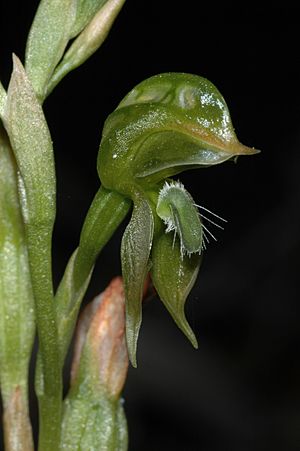Southern rustyhood facts for kids
Quick facts for kids Southern rustyhood |
|
|---|---|
 |
|
| Pterostylis squamata growing near Steiglitz | |
| Scientific classification | |
| Genus: |
Pterostylis
|
| Species: |
squamata
|
| Synonyms | |
The Pterostylis squamata, often called the southern rustyhood or ruddyhood, is a unique plant. It belongs to the amazing orchid family. You can only find this plant growing in south-eastern Australia. When it flowers, it has up to ten green flowers. These flowers have cool reddish-brown markings. They also have a fuzzy, insect-like part called a labellum. When the plant is not flowering, it has a group of four to eight egg-shaped leaves. This orchid looks very similar to another one, Pterostylis rufa. However, Pterostylis rufa has a thinner labellum and other small differences.
Contents
What the Southern Rustyhood Looks Like
The southern rustyhood is a plant that grows from an underground tuber. This means it has a special storage part under the ground. It is a perennial plant, so it lives for more than two years. It is also deciduous, meaning some parts die back each year.
Leaves and Stems
Plants that are not flowering have a group of leaves called a rosette. This rosette has four to eight oblong leaves. Each leaf is about 10 to 30 millimeters (0.4 to 1.2 inches) long. They are also about 7 to 12 millimeters (0.3 to 0.5 inches) wide. Flowering plants have a tall stem, about 100 to 300 millimeters (4 to 12 inches) high. This stem can have up to ten flowers. There are also two to six leaves wrapped around the flowering stem.
Flowers and Their Parts
The flowers are a see-through green color. They have reddish-green marks. The top part of the flower, called the dorsal sepal, joins with the petals. Together, they form a hood over the column. The column is a special part of the orchid flower. The dorsal sepal has a thin, thread-like tip. This tip points upwards and is about 2 millimeters (0.08 inches) long.
The side sepals are about the same width as the hood. They are egg-shaped and point downwards. These sepals are joined for part of their length. They then narrow into a thin, thread-like tip. This tip is about 4 to 7 millimeters (0.16 to 0.28 inches) long.
The Labellum
The most interesting part is the labellum. It looks like an insect! It is about 4 millimeters (0.16 inches) long and 2 millimeters (0.08 inches) wide. It is a dark reddish-brown color and feels fleshy. There are five to seven hairs on each side of the labellum. These hairs can be up to 2 millimeters (0.08 inches) long. Many shorter hairs are found on the "head" end of the labellum. This orchid flowers from October to March.
Naming the Southern Rustyhood
The scientific name for this plant is Pterostylis squamata. It was first officially described in 1810. A botanist named Robert Brown wrote about it. His description was published in a book called Prodromus Florae Novae Hollandiae et Insulae Van Diemen. The second part of its name, squamata, comes from a Latin word. It means "scaly," which might refer to some part of the plant's appearance.
Where the Southern Rustyhood Lives
The southern rustyhood grows in different places. You can find it in heathland, woodland, and forest areas. It often grows near rocky spots. It is found south of the Brindabella Range in New South Wales and the Australian Capital Territory. It is also scattered across Victoria and is common in Tasmania.

